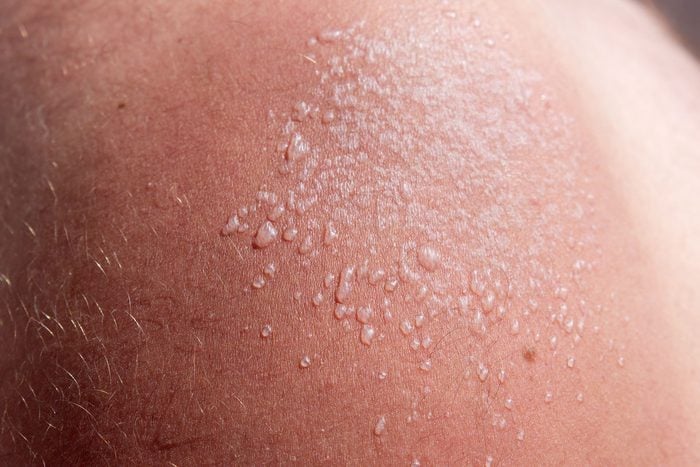Sun Blister: Here’s How to Tell If You Have One, and How to Treat It
Updated: May 11, 2023

Sometimes a day of fun in the sun turns into a bad sunburn, and you might even end up with a second-degree burn. Here's what to do if you you get sun blisters.
Our editors and experts handpick every product we feature. We may earn a commission from your purchases.
Just like everything, sunburn exists on a spectrum, and there’s a big difference between getting a little pink, turning a dark red, and getting too much sun and winding up with a second-degree burn…which usually results in sun blisters.
“Sun blisters are due to radiation damage from both UVA (deeper) and UVB (more superficial) rays,” explains Beth Goldstein, MD, FAAD, a dermatologist specializing in Mohs surgery and co-founder of Modern Ritual Health, a dermatology telemedicine service. “The blistering signals damage at the junction between the top part of the skin, the epidermis and the dermis,” Dr. Goldstein says.
‘What SPF Do I Need?’ Here’s a Dermatologist’s Reliable Method for Choosing
What is a sun blister?
“Sun blisters are fluid-filled bumps on badly sunburned skin, which indicate a second-degree burn,” says Adarsh Vijay Mudgil, MD, a New York City-based dermatologist. “You’ll know you have one if you develop tense, painful blisters on sunburned skin.”
Ken Perry, MD, FACEP, is an emergency room physician in Charleston, SC. Dr. Perry points out that the blisters may be small, but any blistering of the skin is indicative of a burn. “Burns of the skin can happen from hot liquid, or from chemicals, or in the case of a sunburn from UV radiation,” Dr. Perry says.
Sunscreen Safety Is Under Fire This Summer—Doctors Share the Facts
What to do if you have a sun blister?
“Sun blisters need to be treated the same way as blisters from any other burn,” Dr. Perry says, noting that you may be tempted to pop a blister—which seems like it could help control pain or help the skin feel less tight—but you want to do your best to keep them from rupturing, and not to intentionally break your already-damaged skin. “It’s better for infection control to leave them in place,” Dr. Perry says. “If they do open, it is best to put a dressing over them that won’t stick to the skin and keep it very clean and dry.”
Dr. Mudgil recommends ibuprofen or Tylenol to help with the pain, but points out that patience is key and there’s no way to fast-track the process. “Treating sun blisters essentially entails supportive care and ‘waiting it out,'” Dr. Mudgil says.
Dr. Goldstein recommends the following:
- Increase hydration
- Cool compresses
- Oral antihistamines for itching
- Soothing lotions for itchy skin
- Oatmeal baths (think warm water, not hot)
- Pure aloe vera (not the kind with additives)
- Aquaphor to reduce the pain of having exposed nerve endings
- Cicalfate cream to promote healing
- Protect areas from any further sun exposure with clothing and sunscreen
Here’s Exactly What to Look for in a Sunscreen
When to seek medical treatment for sun blisters?
Even the most vigilant sunscreen users occasionally miss a spot. And sometimes we get more sun on one area of our body—often the shoulders or feet—because of how we’re positioned at a ballgame or other event where there isn’t a lot of moving around. If you got more sun that you bargained for and wound up with a few small sun blisters, you can probably self-treat at home, while also being mindful of the symptoms of sun poisoning.
But widespread second-degree burns can have more consequences. “If more than 20% of the body is involved, you can get dehydrated and your body can get quite stressed,” Dr. Goldstein says. “If you have any underlying medical conditions, you need to seek treatment, especially if you are not feeling well with dizziness, headaches, nausea, vomiting or severe chills as this may be a sign of serious dehydration.”
“If you have symptoms that seem to be worsening or worry that your sun blister(s) may be possibly infected, medical care should be sought possibly in the emergency department,” Dr. Perry says, “and if your sun blisters get infected, they may need to be treated with antibiotics.”
Moving forward, that skin will be a bit more tender for a while, and Dr. Mudgil reminds readers that an ounce of prevention is key! “Wearing sunscreen and reapplying as needed is an easy way to prevent a sunburn,” Dr. Mudgil says. “This should be combined with avoiding excessive sun exposure during peak hours, seeking shade when possible and wearing hats.”
